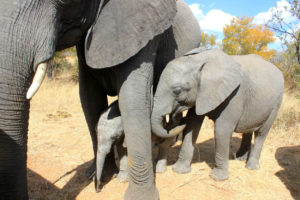 During a heatwave in October, conservation worker Prince Sansole spotted an elephant partially submerged in a muddy pool. His movements initially looked no different from the water games routinely played by the giant creatures. Only a closer look revealed that the young bull was in trouble, struggling to get up. His limp trunk kept dropping back into the water, unable to catch a fresh breath.
During a heatwave in October, conservation worker Prince Sansole spotted an elephant partially submerged in a muddy pool. His movements initially looked no different from the water games routinely played by the giant creatures. Only a closer look revealed that the young bull was in trouble, struggling to get up. His limp trunk kept dropping back into the water, unable to catch a fresh breath.
A postmortem later revealed that the elephant had succumbed to heat stroke on arrival at Chamabonda waterhole, after days of searching in vain for water amid the heat and sand.
But thanks to an emergency effort by a local conservation group, water is now reaching at least 8,000 elephants and up to 10,000 other animals.
Alerted by the predictions of drought, the Victoria Falls-based Bhejane Trust started drilling and setting up solar-powered boreholes in the park in May last year.
Hwange’s animals rely on an artificial supply of water developed in the 1920s. But since the early 2000s, Zimbabwe’s government has let pumps and pipes slide into disrepair. When the rains last failed in 2005, hundreds of elephants died.
“Between August and October, the [water security] situation was dire,†said Trevor Lane, chair of the Bhejane Trust. “We struggled to cope with the very high numbers of animals that congregated daily at the waterholes, and there were plenty of elephants which cluttered up the little available water, making it unusable for other animals.â€
Now the trust operates and maintains a network of 34 boreholes, in collaboration with the parks authority, GroupElephant.com and the Conservation & Wildlife Fund. “At a rough calculation, we are now pumping slightly over 1m litres of water daily,†Lane said.
Replacing diesel-powered engines with solar and windmill powered units has reduced daily operating costs. Previously, Hwange needed at least 14,000 litres of diesel a month.
All forms of human settlement are prohibited within designated park areas, meaning the refurbished water sources are not used by farmers and villagers also hit by the drought. A government act also discourages the sharing of water sources in order to minimise human-wildlife conflict.
The Parks and Wildlife Management Authority (PWMA) of Zimbabwe blames the collapse of the network of diesel-powered water pumps, boreholes and pipelines that supplied the watering pans in Hwange on the withdrawal of US and EU donor support in protest at president Robert Mugabe’s violent farm seizures early in 2000.
According to the PWMA, at least 80 elephants died of drought-related causes in 2012. Many more animals have died in Hwange’s drought, including 620 Cape buffaloes that died in 2015 alone.
The parks authority has also blamed the water crisis in Hwange on a bloated elephant population. It is now estimated to be almost 54,000 against a normal carrying capacity of just 15,000.
A few months ago, the authority announced the capture and relocation of nearly 100 elephants from Hwange to Chizarira national park in Binga to ease the pressure on water sources. At least 30 of those elephants were subsequently sold to Chinese wildlife parks.
Zimbabwe Conservation Task Force chair Johnny Rodrigues dismissed the claim of over-population as a government excuse to justify the continued capture and export of animals to Chinese zoos.
“In Hwange and all of south-western Zimbabwe, drought is not a calamity, but a perpetual condition,†said Rodrigues. “As such, a normal government would have a permanent plan to resolve it. But drought will continue to affect Hwange because the government is more interested in plundering, rather than in conserving the wildlife there.
“If anything, government officials are too busy cutting million-dollar wildlife trade deals with the Chinese who pay to plunder our animals,†he said.
In May this year, the parks authority advertised for prospective buyers “with the capacity to acquire and manage wildlife†to buy animals from the country’s 10 national parks to ease pressure on water resources.
PWMA spokeswoman Caroline Washaya-Moyo did not respond to a request for an interview on the Hwange wildlife water security problem.
Lane said the number of elephants in Hwange national park had grown in the last few years as more cross from Botswana to search of water during the dry season, which runs between July and November.
“The water infrastructure in Botswana is collapsing due to lack of maintenance since the introduction of a hunting ban there in 2014. As a result, more elephants are crossing the border into Hwange, where water security has improved,†he said.
Lane said the recent heavy rains, which fell across north-western Botswana late in December, had replenished a seasonal network of natural water pans, triggering the annual western-bound elephant migration and helping to alleviate pressure from Hwange’s game water sources.
“They will not be back in Zimbabwe until around April next year, and with the pressure off, we will focus on consolidation through the maintenance of existing water points so that they can support more animals in the future,†he said.
Post published in: Agriculture

